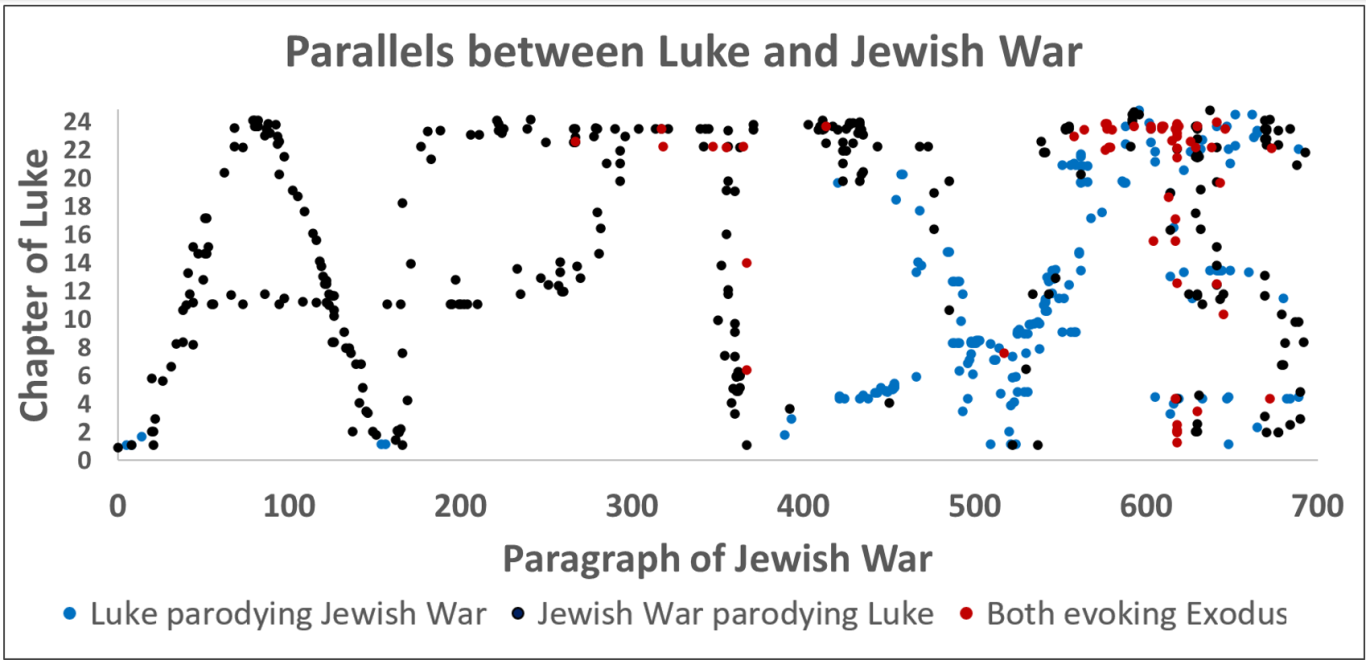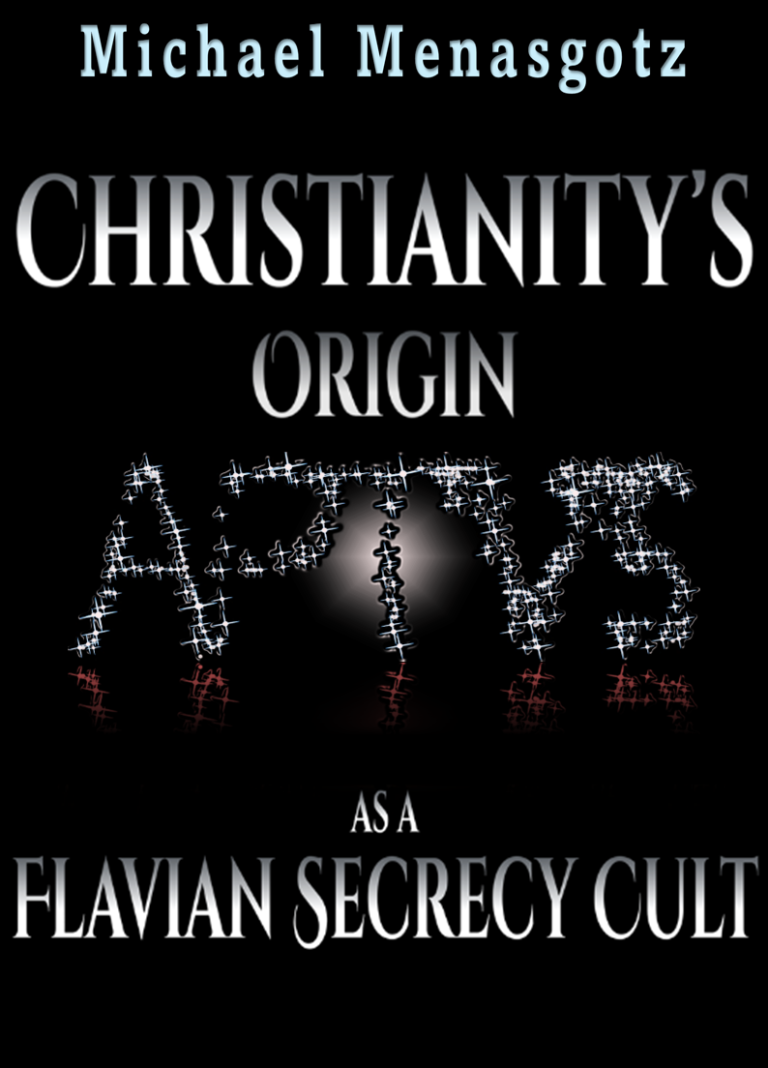"Christianity's Origin as a Flavian Secrecy Cult"
"Christianity’s Origin as a Flavian Secrecy Cult" describes new evidence supporting the increasingly popular idea that the story of Jesus, was not a product of grassroots faith but a carefully designed Roman project - a tool of Imperial control to pacify the Jewish population after the war in Judea, win over the Roman legions, and secure their own rule in a time of political chaos.
Michael Menasgotz' central claim is to have found proof that Jewish War and Luke were written together, whilst his thesis is that this can be explained if early Christianity began as a secrecy cult in which rising converts would have the hidden meanings of the texts revealed to them, to drive them to accept the Emperor as the second coming of Jesus.
New followers would first hear about Jesus as a miracle worker and peace-loving prophet who preached acceptance of Roman authority and taxation. As they advanced, the temple priests would show them - under oath of secrecy - the evidence showing that Jesus' story mirrors that of Emperor Titus, to lead them to see him as the 2nd coming of Jesus, and worship him as god.
Once those followers were hooked on Emperor worship, evidence that Luke and Jewish War were written together, would be then revealed - again under oath of secrecy - thereby demonstrating that Jesus' story originates from the Roman government. This would leave the followers in even greater awe of the Emperor, who would be presented as the author of this literary masterpiece, and cause them to abandon faith in Jesus, thereby achieving the Emperor's goal of turning them into pure Flavian Emperor worshippers.
Menasgotz lays out several types of evidence to support this theory:
Parallels particularly between Jesus and Titus: The book details how the journeys and actions of Jesus in Luke closely mirror those of Titus during the Jewish War, with both figures visiting the same locations and performing similar acts, often in the same sequence - as was previously shown by Joe Atwill. He shows the same is true in the detailed accounts of John (in Luke) and John (in Jewish War). These similarities, Menasgotz argues, are too precise to be accidental.
Hidden meanings and riddles: Many of these parallels contain deeper messages, designed to point initiates toward the divinity of Titus and Vespasian. For example, whilst Jesus talks of the Samaritan who saved a man from robbers being 'he whom you should love', Jewish War portrays Titus as having come through conquering Samaria only to save his men from Jewish leaders described as 'robbers'. In another example Jesus proclaims at the base of Mount Gerizim that his spring will quench whilst earthly water will not, and in Jewish War Vespasian sends his men to surround the based of Mount Gerizim so that the Samaritans would die from lack of earthly water.
Mutual parody: Menasgotz claims that Luke and the Roman account "Jewish War" don’t just contain parallels in one direction —they mutually parody each other's core narratives. He shows for example that Josephus (in Jewish War) is a carefully concealed parody of Jesus in Luke, and that this parody has astonishing amount of carefully concealed detail. Two stories mutually parodying each other's core narratives in great detail, he argues, is only achievable by someone with editorial control over both documents, which means both texts were created together, and since Jewish War is explicitly from the Roman Government, so is the story in Luke.
The APTVS pattern: When the locations of these parallels are plotted, they form the Latin word "APTVS" - the Latin word for "apt" Menasgotz suggests this pattern is deliberate, providing further evidence of design. He explains what the letters appear to stand for (see in Luke: "he who pushes the plough without pause is apt to be in gods kingdom - behold your names are written in the stars" - noting that the Plough is the famous Roman constellation that never sets on the empire), and how they seem intended to be portrayed as a constellation of stars forming the name of a God - a 'Logos' as the Gospel of John puts it. Menasgotz shows how different audiences might be told different things about what the individual letters stand for, one example being 'Agion Pneuma Titvs' (Holy Spirit, Titus).
Passover ritual echoes: Both Luke and "Jewish War" contain passages that reflect the required acts in the Passover ritual, with their placement consistently matching the APTVS pattern. A key point is that every element of the ritual can be found evoked in both stories, and once this is recognized the locations they do so are unambiguous and unarguable, yet in every case (all 40 of them) they match the APTVS pattern - the odds of this being a fluke are astronomically low.
Statistical analysis: The book includes several statistical arguments to show that the number and arrangement of these parallels are vastly beyond what could be expected by chance. For example he shows that the level of detail and precision in the pattern means that for it to be a case of 'finding patterns in noise' would necessitate there to be a lot of 'noise' to select from i.e. Luke would need to contain about 2000 coincidental yet noteworthy parallels with Jewish War, in turn requiring at least 4000 verses, which is physically impossible because Luke only has 1151 verses.
Menasgotz is careful not to overstate his case. He does not claim the Flavians invented Jesus from scratch. He acknowledges that earlier Christian writings, like some of Paul’s letters, predate Titus' reign, though he notes that these letters don’t describe Jesus’s life, making the pauline literature a convenient blank canvas to write Jesus' Gospel story onto. Nor does he argue that the entirety of "Jewish War" was written alongside Luke - only that the accounts of Vespasian and Titus’s victories were crafted with this purpose in mind.
For readers interested in the intersection of religion, history, and politics, Menasgotz’s book offers a detailed and challenging perspective, and certainly an entirely new lens on the origins of Christianity and the power of narrative in shaping belief.

This chart shows the locations of the parallels between Jewish War and Luke.
Michael Menasgotz' four-year effort to catalog the parallels led to the discovery that the noteworthy and seemingly intentional ones are preferentially arranged in lines, forming Latin letters, spelling the Latin word "APTVS".
This is word is found in Luke in the passage: "He who is pushes the Plough (the extremely well-known Roman constellation which never sets on the Roman Empire) is apt to be in the kingdom of heaven (i.e. 'the heavens' or simply 'the firmament'). More speculatively, it appears to be short for "ARES PISO TITVS", as to mean "Divine war god Titus, of the Royal Piso lineage".

As depicted here, Menasgotz shows that the APTVS pattern may have been intended to be presented as stars arranged into a constellation spelling out Titus' desired name, and this may be the Logos that John refers to, namely an image of God's name, shining in the darkness.
